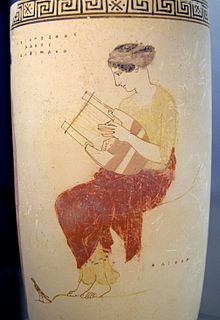
The Greek lyric poet Pindar composed odes to celebrate victories at all four Panhellenic Games. Of his fourteen Olympian Odes, glorifying victors at the Ancient Olympic Games, the First was positioned at the beginning of the collection by Aristophanes of Byzantium since it included praise for the games as well as of Pelops, who first competed at Elis (the polis or city-state in which the festival was later staged).[4] It was the most quoted in antiquity[5] and was hailed as the "best of all the odes" by Lucian.[6] Pindar composed the epinikion in honour of his then patron Hieron I, tyrant of Syracuse, whose horse Pherenikos and its jockey were victorious in the single horse race in 476 BC.[1]
- ^ a b "Olympian I". Perseus Project. Retrieved 9 July 2012.
- ^ Bundrick, Sheramy D. (2005). Music And Image In Classical Athens. Cambridge University Press. p. 26. ISBN 978-0-521-84806-0.
- ^ Oakley, John H. "The Achilles Painter - White Ground: Middle Phase". Perseus Project. Retrieved 14 July 2012.
- ^ Drachmann, A. B. (1903). Scholia Vetera in Pindari Carmina (in Ancient Greek). Vol. I. Teubner. p. 7.
- ^ Bowra, Maurice (1964). Pindar. Oxford University Press. pp. 126f.
- ^ Lucian. "Gallus 7" (in Ancient Greek). Perseus Project. Retrieved 9 July 2012.
